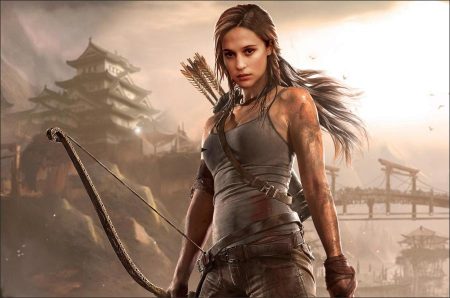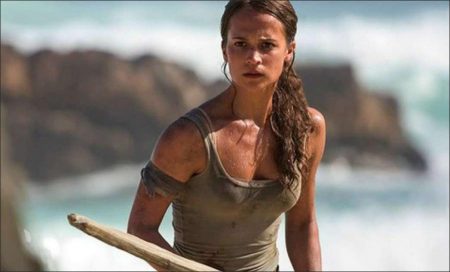Here’s a quick conundrum for you. Your evil arch-enemy is crossing a canyon on a thin, wobbly metal ladder which has been laid across the gap. How do you stop him reaching the other side? Do you…
(a) shake the ladder, thus ensuring that he plunges to his well-deserved doom? Or do you …
(b) leap onto the ladder yourself, thus ensuring that you’re just as likely to plummet to your doom as he is?
If you answered (a), then congratulations, you are officially cleverer than Lara Croft, the dim-witted and generally inept heroine of Tomb Raider.
When the character made her video-game debut in 1996, she was marketed as a cyber sex symbol. The media focused on her rugby ball-shaped breasts, and a waist so minuscule she could have worn a wristwatch around it. But the game’s designers liked to point out that Lara’s IQ was even more stellar than her physical attributes, and by the time Angelina Jolie played her in two films, in 2001 and 2003, they could just about get away with calling her a feminist role model.
Fourteen years on, you might assume that she would be even more capable, and the casting of Alicia Vikander, a multi-lingual Oscar-winning Swedish actress, was certainly encouraging. But, despite the fact that people keep saying how amazingly gifted Lara is, she is so useless that you end up wondering if they are being sarcastic.
We first see her in an East London gym, where she loses a kick-boxing match. She then goes on a bike race around the city, a race she concludes by crashing into a police car. And when her adventures eventually get underway, she is less like James Bond than Inspector Clouseau. In Hong Kong, she wanders around a harbour, bleating, “Excuse me, do you speak English?” She is saved from three muggers by a shotgun-toting sailor (Daniel Wu), and he immediately cracks a code that had baffled her. Some role model.
I appreciate that the Lara in this film is still a trainee tomb raider, so she has an excuse for not being the hyper-confident bad-ass played by Jolie. I also understand that this depiction is true to the game that relaunched the series in 2013. But it isn’t much fun to watch her obeying other people’s instructions, relying on other people to rescue her, and responding to danger with screams and yelps rather than snappy one-liners. Are there really so many proficient big-screen action heroines out there that we now need one who is rubbish at everything?
What’s worse is that Lara’s incompetence is her only distinctive characteristic. Actually, that’s not true. Vikander is absurdly gorgeous, so if you want to watch a muscular young beauty running around in a sweat-soaked camisole, you’ll get your money’s worth from Tomb Raider. But her personality is no more developed than that of Pac-Man or Sonic the Hedgehog.
It was Lara’s father (Dominic West) who trained her in archery and puzzle-solving as a girl, and it is her father’s occult research that inspires her as a woman, but apart from her devotion to daddy’s memory (never mind that he spent most of her childhood disappearing on mysterious expeditions), she doesn’t seem to have any interests or relationships. In the opening London scenes, there is a man in a restaurant kitchen who fancies her, and a woman in the gym who chats to her. Neither of them is ever seen again.
The rest of the film is just as undistinguished as its heroine. Leafing through The Bumper Book of Mystical McGuffins, the screenwriters have stuffed their script with references to “The Devil’s Sea” and “The Chasm of Souls” – which is what you have to do when other screenwriters have already claimed the Egyptian pyramids and the Ark of the Covenant – but the story is drab and predictable. And, yes, it’s all about Lara’s absent father. He vanished seven years earlier after he went in search of an ancient Japanese Empress’s tomb. The Empress, according to legend, had the power to kill anyone she touched, so her own generals buried her on an uncharted island. Now a sinister organisation calling itself The Order of Trinity wants to dig her up and harness her magic, which is why Lara’s dad tried to reach her first.
As well as being worryingly close to the plot of last year’s Tom Cruise debacle, The Mummy, this scenario doesn’t stand up to much scrutiny. If, after all, the Empress’s generals could defeat her 2000 years ago, how much use could her powers possibly be in an age of nerve agents and nuclear weapons? The Order of Trinity might have been better off investing in internet start-ups instead.
Still, this bog-standard premise is sufficient to send Lara to a remote, jungly island, where she is captured by a bog-standard villain (Walton Goggins). And this just-about-good-enough quality runs through the film. None of the digitally-assisted stunts will make you gasp, none of the dialogue will make you laugh, none of the twists will shock you, and none of the elaborate subterranean traps will seem as fiendish as they did when Indiana Jones faced them decades ago.
The London scenes deserve credit for their contemporary, untouristy vision of the city, with glass office blocks around the corner from graffitied alleys. But once Lara washes up on the Empress’s island, the cinematographer sticks to a palette of dingy greys, greens and browns, as if he wasn’t sure whether Tomb Raider was meant to be a blockbuster or a camouflage jacket. Vikander’s earnest performance gives Lara more life and emotion than the screenplay does, but the only truly exciting thing about the film is its director’s name, Roar Uthaug.
Unlike Jolie’s Tomb Raider outings, though, this one is not an incomprehensible mess. Nor is it as terrible as Assassin’s Creed, the recent video-game adaptation starring Vikander’s husband, Michael Fassbender. It’s an efficient franchise-starter and a passable Raiders of the Lost Ark rip-off. It’s competent. And while that’s not saying much, it’s more than can be said for its heroine.
All about Tomb Raider 2018 movie
Views: 562




